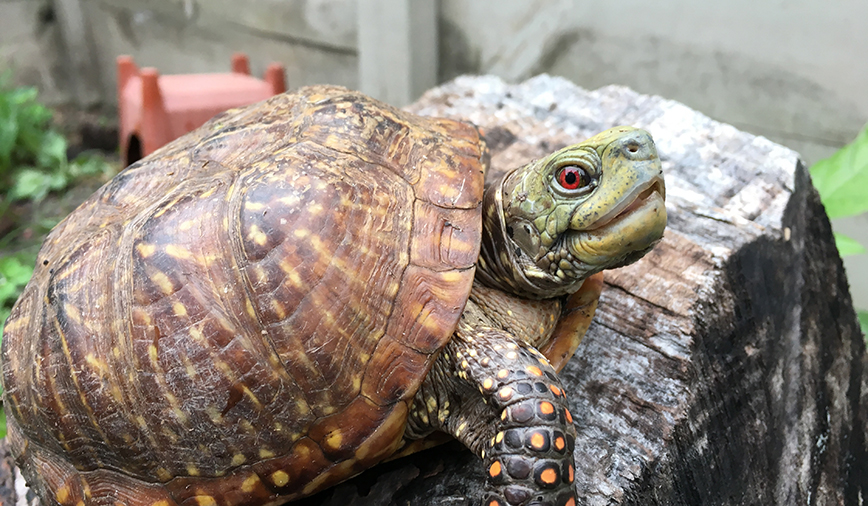November 28, 2014
Artie at Thanksgiving
Ornate box turtles, like Arthur, are a threatened species in Illinois and require a permit from the Illinois Department of Natural Resources if kept in captivity.
I guess we all have our Thanksgiving favorites. My brother likes turkey, and lots of it. I’m partial to stuffing. And my buddy Arthur, he’s a sweet-potato fiend.
Yesterday I watched in amazement as he wolfed down a pile as big as his head. They were made just the way he likes them— baked, no butter, with just a bit of skin left on—and it wasn’t long before every trace had vanished. Well, every trace except the bits that clung to his face and neck. Indeed, the way he tore into his meal, you’d think he hadn’t eaten in days.
Then I realized, gosh, it really had been days since he’d eaten. Three, to be exact.
But that’s OK. Because Arthur isn’t your typical Thanksgiving dinner guest. He’s an ornate box turtle, Terrapene ornata, and I’ve been serving him sweet potatoes, and worms, and other turtle-grade delectables, since 1978.
Artie and I met on Columbus Day of that year in the Noah’s Ark pet store that was then at Aurora’s Fox Valley Mall. I’d wanted a pet turtle for a long time and, that day, my folks finally gave the OK. That I had a learner’s permit and could drive myself to the mall (with my white-knuckled mom riding shotgun) made the day all the more special.
He was in an enclosure with lots of other box turtles, and when his eyes (fireengine red, a trait of male box turtles) met mine, I knew he was the chelonian for me. When I picked him up he hissed, in effect sealing the deal. Thirty-six years later we’re still together, a girl and her turtle.
But Artie’s story also has an element of irony. Because, had I known then what I know now, I never would have gotten him.
Box turtles — in fact, turtles of many species — are in a tough spot these days. Habitat loss has hit them hard. And, as more and more roads traverse turtles’ home ranges, more and more are getting hit by cars. Over the decades I’ve had Arthur, the ornate box turtle’s status in Illinois has slipped to the point where it has been listed as a threatened species. I never thought I’d need to file paperwork in order to keep a pet, but due to the decline I now have a Permit for Possession of Endangered or Threatened Species on file with the Illinois Department of Natural Resources.
What bothers me most is that box turtles have suffered huge losses thanks to the very means that brought Artie to me – the pet trade. Only recently have states started to clamp down on the capture of wild turtles. And, even then, many of the clamps aren’t very tight. Lots of wild-caught animals are still making their way into pet stores and reptile swap meets.
With the December holidays just around the corner, you or someone you know may be considering giving or getting the gift of a pet turtle. While that may seem like a fine idea, just be sure you or the intended recipient knows what lies ahead.
For one thing, turtles live a long time. A really long time. Artie was no kid when
I got him and, all these years later, he’s still going strong. With box turtles, life spans of 50 years or more are the norm, not the exception. For other species, such as red-eared sliders, average life expectancy is maybe 35 years — less than a box turtle, yes, but still considerably longer than the three or four years you can expect from a hamster or gerbil. When you get a turtle as a pet, be prepared to be committed to it for decades to come.
This longevity is contingent on proper care — a balanced, species-appropriate diet, clean water, a temperature gradient that allows both basking and cooling, as well as a light source that supplies both UV-A and UV-B rays. For aquatic species, don’t forget to factor in a large aquarium or indoor pond along with a heavy-duty filtration system. None of this comes cheap.
Also keep in mind a turtle’s adult size. If you’re looking to acquire, for example, a red-eared slider, and pick out one the size of your palm, it’s probably still a youngster. Female red-eared sliders, which typically grow larger than males, can measure a foot or more as adults. That 20-gallon aquarium that seems adequate for young Shelly will soon be way too small.
Finally, inquire as to where the turtle you’re interested in originated. Don’t accept “wild caught” as an answer; “captive bred” or “rehomed” is what you want to hear. If no captive breeding programs exist for the species you’re interested in, check Web sites such as PetFinder.com or clubs such as The Chicago Herpetological Society, which has an active adoption program for turtles (and lots of other reptiles) in need of new homes. Or, if you want, give us a call. We might be able to hook you up with the species you’re seeking.
Remember though – a life span of 50 years or more. It’s a long time. Just ask Artie.
Pam Otto is the manager of nature programs and interpretive services at the Hickory Knolls Discovery Center, a facility of the St. Charles Park District. She can be reached at potto@stcparks.org or 630-513-4346.

